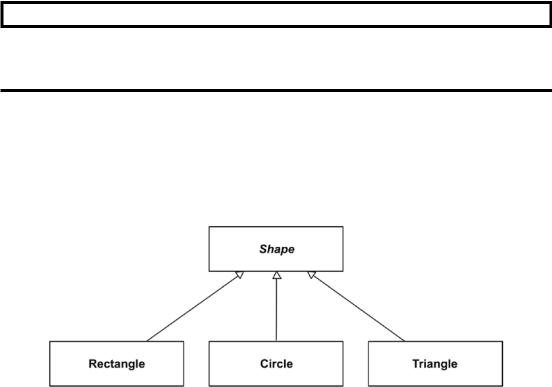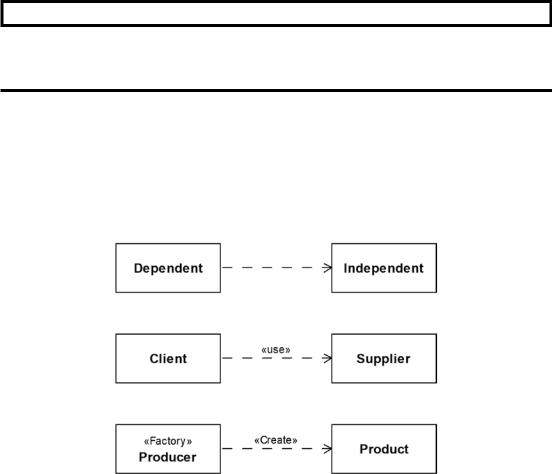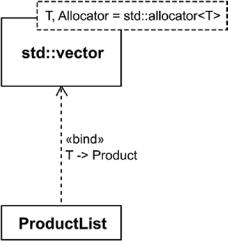
- •Table of Contents
- •About the Author
- •About the Technical Reviewer
- •Acknowledgments
- •Software Entropy
- •Clean Code
- •C++11: The Beginning of a New Era
- •Who This Book Is For
- •Conventions Used in This Book
- •Sidebars
- •Notes, Tips, and Warnings
- •Code Samples
- •Coding Style
- •C++ Core Guidelines
- •Companion Website and Source Code Repository
- •UML Diagrams
- •The Need for Testing
- •Unit Tests
- •What About QA?
- •Rules for Good Unit Tests
- •Test Code Quality
- •Unit Test Naming
- •Unit Test Independence
- •One Assertion per Test
- •Independent Initialization of Unit Test Environments
- •Exclude Getters and Setters
- •Exclude Third-Party Code
- •Exclude External Systems
- •What Do We Do with the Database?
- •Don’t Mix Test Code with Production Code
- •Tests Must Run Fast
- •How Do You Find a Test’s Input Data?
- •Equivalence Partitioning
- •Boundary Value Analysis
- •Test Doubles (Fake Objects)
- •What Is a Principle?
- •KISS
- •YAGNI
- •It’s About Knowledge!
- •Building Abstractions Is Sometimes Hard
- •Information Hiding
- •Strong Cohesion
- •Loose Coupling
- •Be Careful with Optimizations
- •Principle of Least Astonishment (PLA)
- •The Boy Scout Rule
- •Collective Code Ownership
- •Good Names
- •Names Should Be Self-Explanatory
- •Use Names from the Domain
- •Choose Names at an Appropriate Level of Abstraction
- •Avoid Redundancy When Choosing a Name
- •Avoid Cryptic Abbreviations
- •Avoid Hungarian Notation and Prefixes
- •Avoid Using the Same Name for Different Purposes
- •Comments
- •Let the Code Tell the Story
- •Do Not Comment Obvious Things
- •Don’t Disable Code with Comments
- •Don’t Write Block Comments
- •Don’t Use Comments to Substitute Version Control
- •The Rare Cases Where Comments Are Useful
- •Documentation Generation from Source Code
- •Functions
- •One Thing, No More!
- •Let Them Be Small
- •“But the Call Time Overhead!”
- •Function Naming
- •Use Intention-Revealing Names
- •Parameters and Return Values
- •Avoid Flag Parameters
- •Avoid Output Parameters
- •Don’t Pass or Return 0 (NULL, nullptr)
- •Strategies for Avoiding Regular Pointers
- •Choose simple object construction on the stack instead of on the heap
- •In a function’s argument list, use (const) references instead of pointers
- •If it is inevitable to deal with a pointer to a resource, use a smart one
- •If an API returns a raw pointer...
- •The Power of const Correctness
- •About Old C-Style in C++ Projects
- •Choose C++ Strings and Streams over Old C-Style char*
- •Use C++ Casts Instead of Old C-Style Casts
- •Avoid Macros
- •Managing Resources
- •Resource Acquisition Is Initialization (RAII)
- •Smart Pointers
- •Unique Ownership with std::unique_ptr<T>
- •Shared Ownership with std::shared_ptr<T>
- •No Ownership, but Secure Access with std::weak_ptr<T>
- •Atomic Smart Pointers
- •Avoid Explicit New and Delete
- •Managing Proprietary Resources
- •We Like to Move It
- •What Are Move Semantics?
- •The Matter with Those lvalues and rvalues
- •rvalue References
- •Don’t Enforce Move Everywhere
- •The Rule of Zero
- •The Compiler Is Your Colleague
- •Automatic Type Deduction
- •Computations During Compile Time
- •Variable Templates
- •Don’t Allow Undefined Behavior
- •Type-Rich Programming
- •Know Your Libraries
- •Take Advantage of <algorithm>
- •Easier Parallelization of Algorithms Since C++17
- •Sorting and Output of a Container
- •More Convenience with Ranges
- •Non-Owning Ranges with Views
- •Comparing Two Sequences
- •Take Advantage of Boost
- •More Libraries That You Should Know About
- •Proper Exception and Error Handling
- •Prevention Is Better Than Aftercare
- •No Exception Safety
- •Basic Exception Safety
- •Strong Exception Safety
- •The No-Throw Guarantee
- •An Exception Is an Exception, Literally!
- •If You Can’t Recover, Get Out Quickly
- •Define User-Specific Exception Types
- •Throw by Value, Catch by const Reference
- •Pay Attention to the Correct Order of Catch Clauses
- •Interface Design
- •Attributes
- •noreturn (since C++11)
- •deprecated (since C++14)
- •nodiscard (since C++17)
- •maybe_unused (since C++17)
- •Concepts: Requirements for Template Arguments
- •The Basics of Modularization
- •Criteria for Finding Modules
- •Focus on the Domain of Your Software
- •Abstraction
- •Choose a Hierarchical Decomposition
- •Single Responsibility Principle (SRP)
- •Single Level of Abstraction (SLA)
- •The Whole Enchilada
- •Object-Orientation
- •Object-Oriented Thinking
- •Principles for Good Class Design
- •Keep Classes Small
- •Open-Closed Principle (OCP)
- •A Short Comparison of Type Erasure Techniques
- •Liskov Substitution Principle (LSP)
- •The Square-Rectangle Dilemma
- •Favor Composition over Inheritance
- •Interface Segregation Principle (ISP)
- •Acyclic Dependency Principle
- •Dependency Inversion Principle (DIP)
- •Don’t Talk to Strangers (The Law of Demeter)
- •Avoid Anemic Classes
- •Tell, Don’t Ask!
- •Avoid Static Class Members
- •Modules
- •The Drawbacks of #include
- •Three Options for Using Modules
- •Include Translation
- •Header Importation
- •Module Importation
- •Separating Interface and Implementation
- •The Impact of Modules
- •What Is Functional Programming?
- •What Is a Function?
- •Pure vs Impure Functions
- •Functional Programming in Modern C++
- •Functional Programming with C++ Templates
- •Function-Like Objects (Functors)
- •Generator
- •Unary Function
- •Predicate
- •Binary Functors
- •Binders and Function Wrappers
- •Lambda Expressions
- •Generic Lambda Expressions (C++14)
- •Lambda Templates (C++20)
- •Higher-Order Functions
- •Map, Filter, and Reduce
- •Filter
- •Reduce (Fold)
- •Fold Expressions in C++17
- •Pipelining with Range Adaptors (C++20)
- •Clean Code in Functional Programming
- •The Drawbacks of Plain Old Unit Testing (POUT)
- •Test-Driven Development as a Game Changer
- •The Workflow of TDD
- •TDD by Example: The Roman Numerals Code Kata
- •Preparations
- •The First Test
- •The Second Test
- •The Third Test and the Tidying Afterward
- •More Sophisticated Tests with a Custom Assertion
- •It’s Time to Clean Up Again
- •Approaching the Finish Line
- •Done!
- •The Advantages of TDD
- •When We Should Not Use TDD
- •TDD Is Not a Replacement for Code Reviews
- •Design Principles vs Design Patterns
- •Some Patterns and When to Use Them
- •Dependency Injection (DI)
- •The Singleton Anti-Pattern
- •Dependency Injection to the Rescue
- •Adapter
- •Strategy
- •Command
- •Command Processor
- •Composite
- •Observer
- •Factories
- •Simple Factory
- •Facade
- •The Money Class
- •Special Case Object (Null Object)
- •What Is an Idiom?
- •Some Useful C++ Idioms
- •The Power of Immutability
- •Substitution Failure Is Not an Error (SFINAE)
- •The Copy-and-Swap Idiom
- •Pointer to Implementation (PIMPL)
- •Structural Modeling
- •Component
- •Interface
- •Association
- •Generalization
- •Dependency
- •Template and Template Binding
- •Behavioral Modeling
- •Activity Diagram
- •Action
- •Control Flow Edge
- •Other Activity Nodes
- •Sequence Diagram
- •Lifeline
- •Message
- •State Diagram
- •State
- •Transitions
- •External Transitions
- •Internal Transitions
- •Trigger
- •Stereotypes
- •Bibliography
- •Index

Appendix A Small UML Guide
Table A-2. Multiplicity Examples
Multiplicity Meaning
1 |
Exactly one. If no multiplicity is shown on an association end, this is the default. |
1..10 |
An inclusive interval between 1 and 10. |
0..* |
An inclusive interval between 0 and any number (zero-to-many). The star character (*) |
|
is used to represent the unlimited (or infinite) upper bound. |
*Abbreviated form of 0..*.
1..* |
An inclusive interval between 1 and any number (one-to-many). |
|
|
In programming languages, associations and the mechanism of navigation from one class to another can be implemented in various ways. In C++, associations are usually implemented by members having the other class as its type, for example, as a reference or a pointer, as shown in Listing A-3.
Listing A-3. Sample Implementation of a Navigable Association Between Classes A and B
class B; // Forward declaration
class A { private:
B* b; // ...
};
class B {
// No pointer or any other reference to class A here!
};
Generalization
A central concept in object-oriented software development is the so-called inheritance. In UML there is a different and better fitting term for this concept: generalization. What is meant by this is the generalization of, for instance, classes or components.
462

Appendix A Small UML Guide
GENERALIZATION
A generalization is a taxonomic relationship between a general class and a more specific class.
The generalization relationship is used in UML diagrams to represent the concept of inheritance: the specific class (subclass) inherits attributes and operations of the more general class (base class). The UML syntax of the generalization relationship is a solid arrow with a closed but not filled arrowhead, as depicted in Figure A-11.
Figure A-11. An abstract base class called Shape and three concrete classes that are specializations of it
In the direction of the arrow, this relationship is read as the following: “<Subclass> is a kind of <Baseclass>,” for example, “Rectangle is a kind of Shape.”
Dependency
In addition to the already mentioned associations, classes (and components) can have further relationships with other classes (and components). For instance, if a class is used as a type for a parameter of a member function, this is not an association, but it is a kind of dependency to that used class.
463

Appendix A Small UML Guide
DEPENDENCY
A dependency is a relationship that signifies that a single or a set of elements requires other elements for their specification or implementation.
As depicted in Figure A-12, a dependency is shown as a dashed arrow between two elements, for example, between two classes or components. It implies that the element at the arrowhead is required by the element at the tail of the arrow, for example, for implementation purposes. In other words, the dependent element is incomplete without the independent element.
Figure A-12. Miscellaneous dependencies
In addition to its simple form (see the first example in Figure A-12), two special types of dependency can be distinguished:
•\ |
The usage dependency («use») is a relationship in which one |
|
element requires another element (or set of elements) for its full |
|
implementation or operation. |
•\ |
The creation dependency («Create») is a special kind of usage |
|
dependency indicating that the element at the tail of the arrow |
|
creates instances of the type at the arrowhead. |
464

Appendix A Small UML Guide
Template and Template Binding
In C++, templates are well known as the foundation of generic programming. In contrast, the possibility of depicting class templates in UML class diagrams is largely unknown, as is the possibility to show how template parameters are substituted with concrete types or values.
The example in Figure A-13 shows a class template named std::vector with two formal template parameters named T and Allocator. Template parameters of a Class template are shown in a dashed rectangle that overlaps the class’ rectangle in the upper- right corner. In our example, there is even a default value (std::allocator) with which the Allocator template parameter is substituted.
Figure A-13. The class template std::vector and a bound class ProductList
There is also a bound class (named ProductList) that substitutes the template parameter T with the type Product (which is another class that is not shown here). The TemplateBinding is depicted with a dashed arrow («bind») showing the substitution of template parameters (T -> Product).
465
